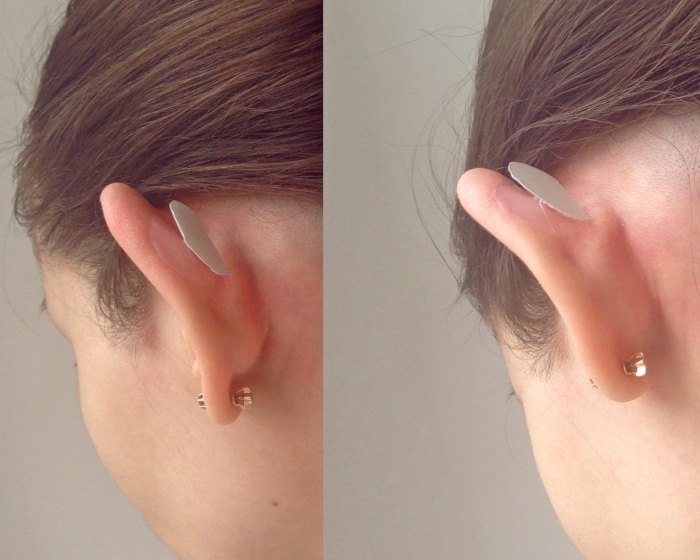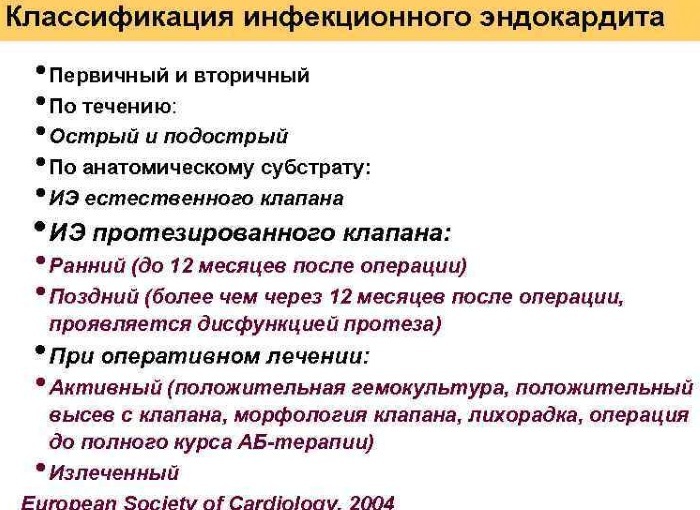Content
- The essence of the method
- Operational concept
- Stages of development of children's intelligence
- Sensomotor period (0-2 years)
- Definition test
- Period of preoperative representations (2-7 years)
- Definition test
- Period of specific operations (7-11 years)
- Definition test
- Period of formal operations (after 12 years)
- Definition test
- How intelligence is related to speech
- Criticism of the main provisions of the theory
- Video about the stages of development of intelligence according to Piaget
Such a concept as child development is inextricably linked with the name of the Swiss philosopher and psychologist Jean Piaget. The researcher judged the changes in the child's logic by experiments.In the course of the experiments, the scientist established the mechanisms for the development of children's perception of the world, studied the general concept of thought processes. They were offered the main stages of the development of intelligence.
The essence of the method
At a young age, Jean Piaget was fond of biology, constantly observing animals. The future scientist in the field of psychology described the obtained conclusions in detail in articles. The basis of his scientific life was the identification of the characteristics of children's and adolescent thinking.
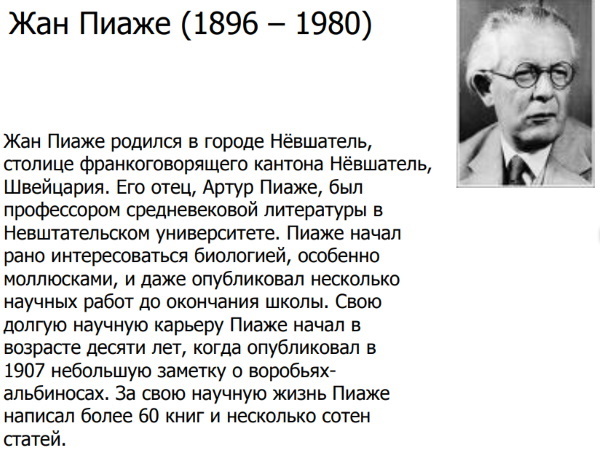
The young explorer became a teacher at a boys' school in Paris. The director of the school was Binet, the inventor of IQ testing. Piaget collaborated with the manager, constantly assisting him in processing the results.
According to the observations of a psychoanalyst, children of the same age group made approximately the same mistakes that adults never did. This became the basis of the future theory, which is that a person's thinking undergoes a certain transformation at each age stage.
Piaget watched not only schoolchildren, but also his own children. Experiments were the basis of the scientist's scientific work. Also, the psychologist used the method of conversation, which gave him a broad understanding of children's logic.
According to Piaget's theory, the main pivot of the development of the mental sphere is intelligence.
Gradually, the child develops a more adequate scheme for understanding a certain situation, adaptation is traced, which occurs when interacting with the environment. Typical logical errors are inherent in each stage.
Operational concept
Piaget's stages of intelligence development include various indicators.
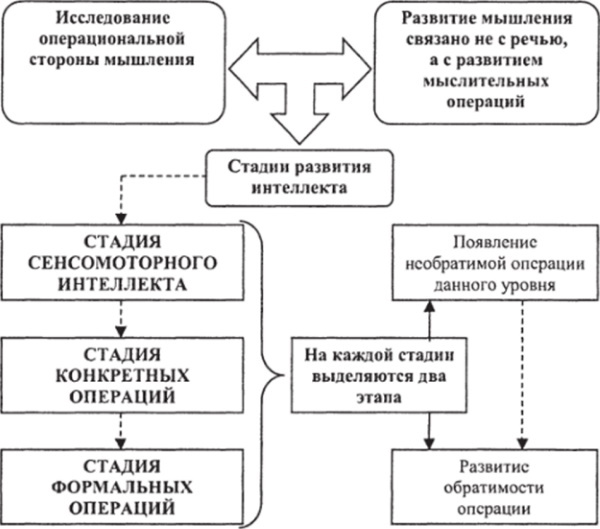
The table presents four main indicators:
| Index | Peculiarities |
| Homeostasis (balance with the environment) | Life is an example of constant process disruption. The body is active in order to compensate. The main product of activity is the striving for balance. |
| Biological maturation | Is the basis for development, but does not act as a fundamental factor in determining the patterns of growth of thinking. |
| Manifestation of personal activity | The source of comprehension of the surrounding world is the continuous interaction between the subject and the object. |
| Social experience | The child masters language, values of an intellectual and social nature. However, the assimilation of experience occurs depending on development and mental abilities. Intelligence is the main lever for the assimilation of social experience. The view is fundamentally different from the scientific works of Soviet psychologists, in whose opinion socialization is a mental product. |
The stages of intelligence development are based on the main mechanism. According to Piaget, balance plays its role. The higher the evolutionary stage a person occupies, the more often he resorts to anticipation, which helps to find the lost balance.
Intelligence serves as the main means of adaptation, acts as the basis for structuring the relationship between the individual and the world.
In his early writings, the psychologist paid great attention to heredity and the environment, but in later scientific research he increasingly turned to such a determinant as the activity of the subject. The structure is the fruit of action, while the drive for this process is determined by genetic prerequisites.
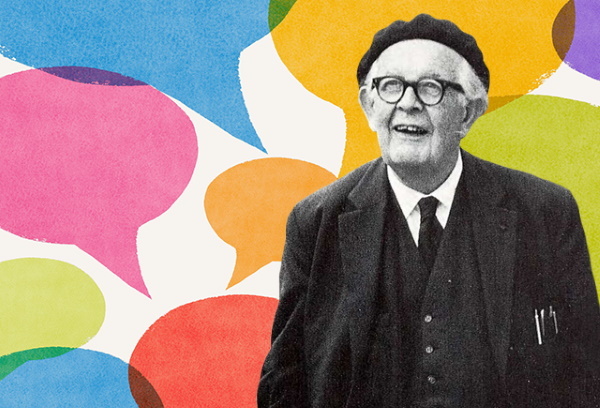
Intellectual development presupposes a sequential change of logical mechanisms, the ultimate goal of which is the formation of formal logical operations. All researches of the scientist were based on the explanation of the emergence of certain stereotypes of thinking in a particular age group.
The most important unit in Piaget's teachings is adaptation. Full balance is provided by intellectual capabilities. The process represents equilibration and further assimilation and accommodation. The first concept presupposes the inclusion of an object in action schemes.
For example, such an unconditioned reflex as sucking involves the expansion of the number of objects. Accommodation is a change in the principle of action in accordance with the intellectual characteristics of the individual.
When a child sucks on a pacifier and tries to do the same with a blanket or a finger, he transforms his personal scheme of action, taking into account the appearance of new objects. Accommodation presupposes the expansion of acquired skills, while assimilation is responsible for their preservation.
Stages of development of children's intelligence
The stages of development of intelligence (according to Piaget, 4 levels are assumed) are described in the cognitive theory of the scientist. Initially, the formation of sensorimotor structures occurs, suggesting the reversibility of the action.
Then preoperative representations emerge, which are the basis for the development of specific mental operations, suggesting a systematic nature of actions. They are often carried out based on visual data. And the final stage is the formal layer of intelligence.
This period is based on hypothetical-deductive reasoning. According to Piaget's teachings, development is a transition from a lower to a higher level. The previous stage is the basis for the next level. In development, it is not the replacement of one layer with another that takes place, but their integration.
Each stage is transformed into a more perfect level, which is characterized by a unique structure. But all stages have common functional indicators. To characterize the levels, the scientists used a logical model.
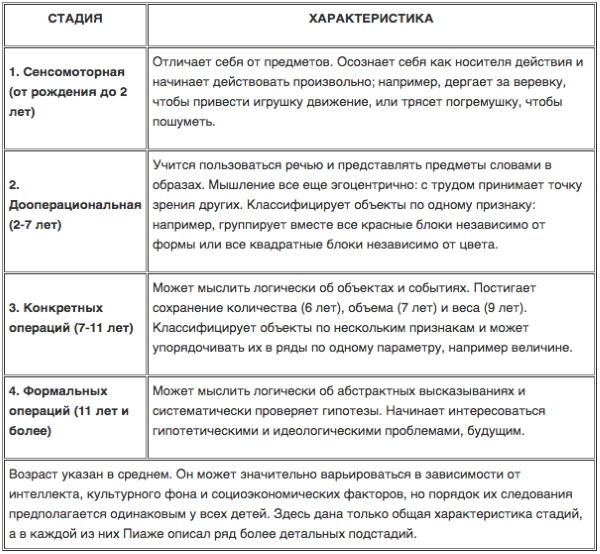
Piaget noted that no quantitative measurements are used in the analysis of structures. The basis is the qualitative characteristic of mental abilities. The logical model was a tool for analyzing psychological reality.
Sensomotor period (0-2 years)
Through the sense organs and motor ability, the child learns the world around him, begins to establish the simplest connections between his actions and consequences.
He realizes that he is a separate subject. But the inner plan of the child's thinking is not available. He can only manipulate specific items.
Definition test
First of all, the child understands that objects remain intact and change in time and space. If you hide a toy under a blanket, to which a 6-month-old baby is reaching, then he will stop and lose interest in the subject, as if the toy had ceased to exist.
Based on the experience, Piaget concluded that the child does not have an innate understanding of the constancy of the object and acquires it during the first year of life. Awareness of constancy, according to the scientist, is a slow process.
And the baby's action is a major achievement of intelligence at the level of sensorimotor perception of the world.
Period of preoperative representations (2-7 years)
According to Piaget, the developmental stages of intelligence include the preoperative level. The formation of the children's internal plan begins with him. The child learns to symbolize objects. For example, a pencil is represented as a thermometer, and a box lid is represented as a boat.

But some phenomena are not comprehended by the child's consciousness. For example, according to a child, there are more objects in the same row if they are spaced at large intervals, and the rope becomes shorter when it bends.
Definition test
Piaget showed the child a model of three mountains. On each dais there was a distinctive sign: a house, a river and a peak covered with snow. Children were given photographs in which the hills were shot from different angles. The participant in the experiment had to choose the photo in which they are depicted as he sees them.
The choice was unmistakable. After that, a doll was seated on the opposite side, and Piaget asked to choose an image based on how the toy sees it. And the children again chose the old photo. They could not visualize the picture from the side of another object.
The second experiment consisted in the fact that the child was shown two glasses, which were filled with water to the same mark. The subject was then asked whether he believed that the volume of liquid in the two containers was the same, since it was important to be aware of this fact. Then the water poured from a narrow tall glass into a wide and low one.
Usually the experimenter focused on his action. The participant was then asked if the amount of liquid in both glasses was the same. Usually a child under 7 years old could not cope with a similar task of preservation.
The child was sure that there is more fluid in one of the vessels, since there is no awareness of the safety of objects when it changes at the perceptual level.
The preschooler thinks egocentrically, relying solely on personal perception. It is focused on the present moment, focusing only on the height of the liquid, not considering the shape of the glass. Piaget regards the lack of preservation as an indicator of the inability of children's thinking to decentrate and build a logical chain.
The scientist emphasized that the child begins to get rid of egocentrism with the expansion of experience and the realization that his point of view is possible, but not the only one. The psychologist considered this transition to decentration to be a mechanism of development.
Period of specific operations (7-11 years)
At this stage, the child not only uses symbols, but also applies them in solving logical problems. For example, it shows the ability to classify objects. Begins to become aware of the conservation of matter and the reversibility of operations.

Logical operations are a mental action that is characterized by reversibility. For example, this concept applies to subtraction and addition in mathematics. Children's thinking is not yet ready for generalization.
Having solved the problem about a boy and apples, the child makes a mistake when calculating a similar problem about a girl and pears, since he perceives the conditions as different. A second grade student already understands why a square is a kind of a quadrangle, and a chicken is a bird.
But for the relationship of the relationship between the part and the whole, a developed logic is required, which is formed later.
Children who have achieved concrete thinking are able to reason about the world in which they live. They are able to reason about future events, make guesses and test their arguments.
However, they can only judge about specific objects and social phenomena that they observe and check. There is no abstract thinking. It develops at the stage of formal operations at the age of 11-12 years.
Definition test
Children who have reached the level of specific operations come to the realization that differences between similar objects can be measured. In a famous experiment, Piaget showed two curved lines: one of them was made of 6 matches, and the other was made of 5. The child could understand that the first figure was longer than the second.
The transition from the pre-operational stage to concrete-operational thinking does not occur immediately. This developmental goal is achieved through the experience accumulated over the years, the manipulation of various objects and materials in the child's environment, as well as the knowledge of their properties.
According to Piaget, children acquire a more complex and subtle form of thinking in the process of actively exploring the physical environment, asking themselves questions and mainly finding answers to them.
Period of formal operations (after 12 years)
At this stage, the teenager is able to think concretely and abstractly.
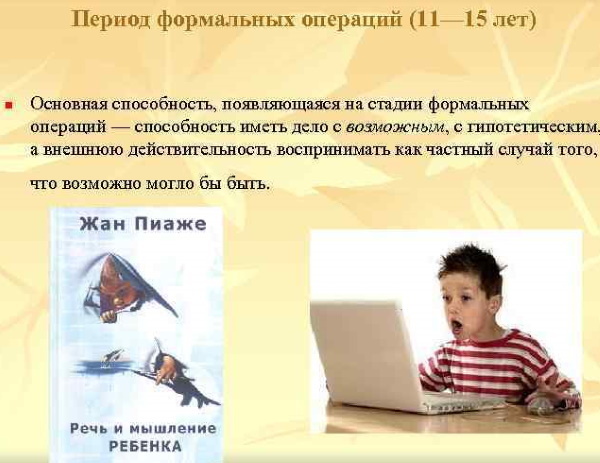
He is able to draw non-existent objects in his imagination or think by analogy, realize the essence of metaphorical meanings, take the point of view of another person. Operations are transferred to the internal plan.
Definition test
Piaget performed the famous pendulum experiment. A group of teenagers was shown an object that was hanging by a thread. It was necessary to decide what affects the speed of the swing of the pendulum.
The study underwent a change:
- suspension level;
- masses of the mint;
- heights;
- force applied to the pendulum.
The problem could have been solved in any way. This is a hypothetical-deductive layer of thinking, in which the scientific method is applied. At the same time, one indicator varies, the rest remain unchanged.
The formal stage is final. It presupposes the development of abstraction that does not depend on specifics.
In the behavior of the subjects, the scientists noted the following features:
- a systematic plan was drawn up (the question was solved, what is the length of the thread and the weight of the load);
- accurate and objective records of the results obtained were kept;
- logical arguments are given.
The adolescents intuitively understood that one indicator of the pendulum should be changed at a certain moment, so as when changing several characteristics at the same time, they will not be able to decide which one caused the changes in speed.
How intelligence is related to speech
Piaget was the first to suggest that the thought process is not associated with speech activity. The inability to speak, according to the scientist, is not a hindrance to the development of the baby. The basis of intelligence is not words, but the skill of connecting objects and concepts in a logical chain.

Development is always directed from outside to inside and from concrete to abstraction. Many views of the psychologist have been improved, and the conclusions have been repeatedly tested and corrected. Currently, analogs of the experiments carried out are used in the diagnosis of the development of children.
It should be noted that none of the above stages can be outstripped or accelerated. Although at the end of the previous stage, the child can be assigned tasks of the next level. For example, playing "phone" with a 2-year-old toddler, putting a fake mobile phone to his ear.
You can show children 5 years old that a large object can be of small weight and vice versa, write an essay with a child 10 years old from the point of view of his friend.
Criticism of the main provisions of the theory
Many scientists reacted critically to Piaget's idea of the nature of intellectual capabilities and the factors of their development. In his scientific work, the researcher did not deny the social role, but considered the biological factor to be decisive.
According to the psychologist, favorable conditions can only accelerate the change of stages, but no more. On this issue, L. Vygotsky, M. Cole, Alexey Leontiev and many others. Often disagreements in academic circles were caused by the differentiation of age periods and stages of thinking.
The psychologist believed that the age range was determined with precision, but their variability depends on the specific sample of the child. According to Piaget, the formal layer of logic is already becoming available to adolescents.
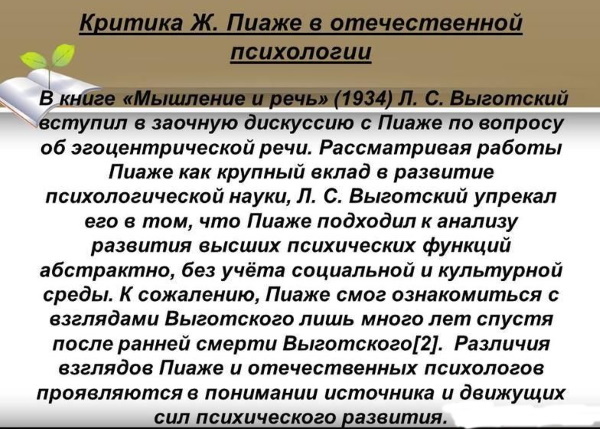
But many experiments by other researchers have shown that young men and women often do not cope with the tasks assigned to them.
Research by L.S. Vygotsky, A.N. Leontiev, M. Cole, J. Vercia does not contradict Piaget's scientific views that the formal logical stage of development is considered the highest link, however, psychologists, in particular Daniil Elkonin, doubted that after 15 years the intellect ceases to undergo changes.
After all, a complex skill or activity requires constant improvement, and the thinking of a young person is fundamentally different from the logic of an experienced leader.
Video about the stages of development of intelligence according to Piaget
Jean Piaget's theory of cognitive development:


